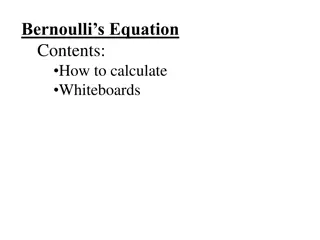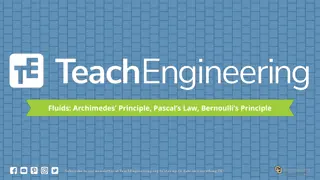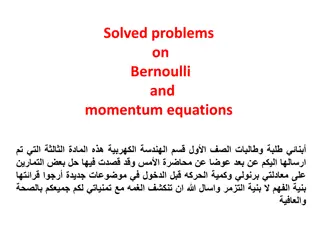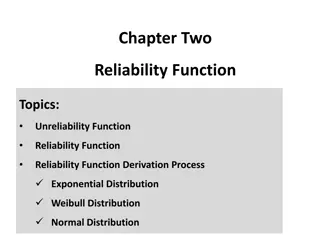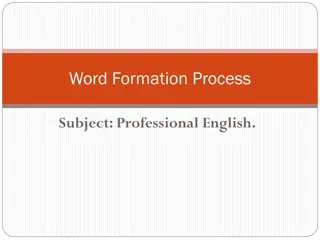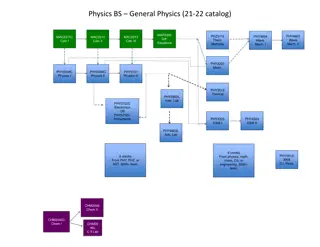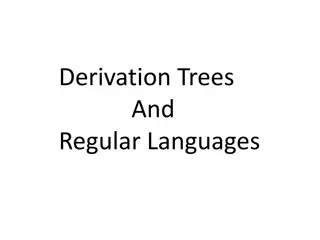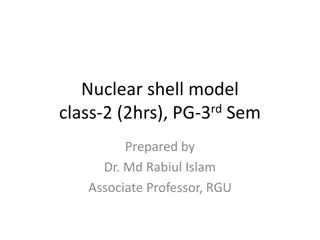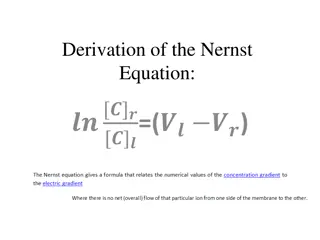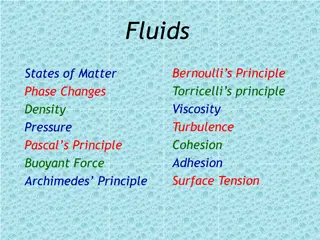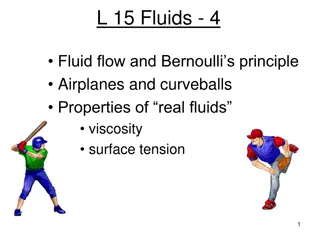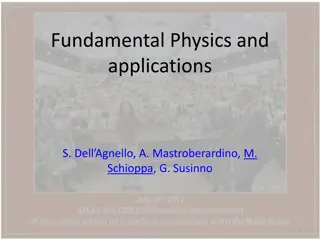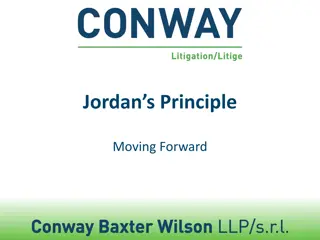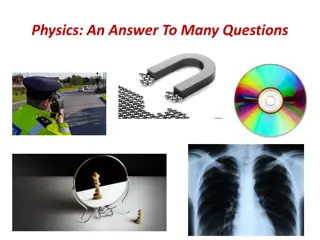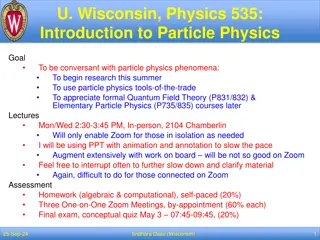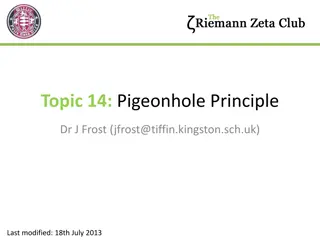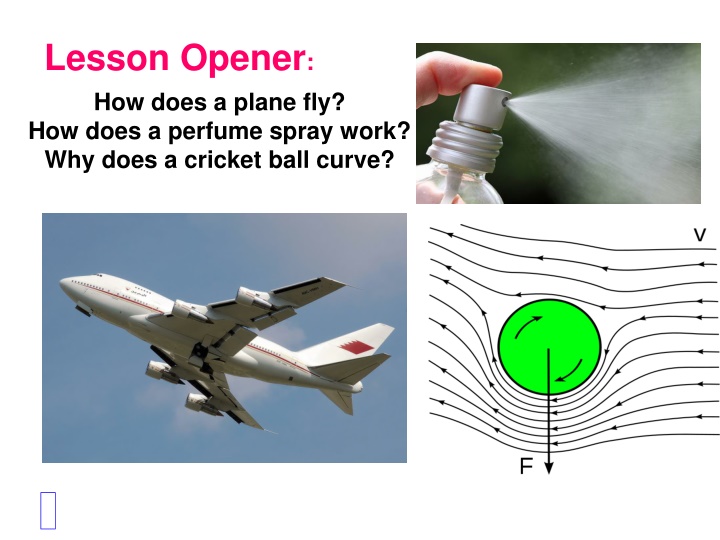
Derivation and Applications of Bernoulli's Principle in Physics
Exploring the principles of fluid dynamics through the eyes of Bernoulli. Understand how the speed of a fluid affects its pressure and how this concept is applied in various scenarios. Dive into the derivation and applications of Bernoulli's equation, shedding light on the relationship between velocity, pressure, and energy in fluid flow. Unravel the mystery behind phenomena like plane flight, perfume spray, and cricket ball curves. Discover the beauty of physics in action!
Download Presentation

Please find below an Image/Link to download the presentation.
The content on the website is provided AS IS for your information and personal use only. It may not be sold, licensed, or shared on other websites without obtaining consent from the author. If you encounter any issues during the download, it is possible that the publisher has removed the file from their server.
You are allowed to download the files provided on this website for personal or commercial use, subject to the condition that they are used lawfully. All files are the property of their respective owners.
The content on the website is provided AS IS for your information and personal use only. It may not be sold, licensed, or shared on other websites without obtaining consent from the author.
E N D
Presentation Transcript
Lesson Opener: How does a plane fly? How does a perfume spray work? Why does a cricket ball curve?
Derivation and Applications of the Bernoulli Principal NIS Taldykorgan Grade 11 Physics Lesson Objective: 1.To apply Bernoulli s equation to solve problems Daniel Bernoulli (1700 1782) 2.To describe Bernoulli s principle and to derive his formula in terms of conservation of energy 3.To present applications of the Bernoulli principle
Bernoullis Principle As the speed of a fluid goes up, its pressure goes down! The pressure in a fast moving stream of fluid is less than the pressure in a slower stream Fast stream = low air pressure Slow stream = High air pressure
p large p large p small v small A1 v large v small A1 A2 v2 v1 v1 Low speed Low KE High pressure high speed high KE low pressure Low speed Low KE High pressure
Bernoullis Equation in terms of Fluid Energy for any point along a flow tube or streamline P + v2 + g h = constant Each term has the dimensions of energy / volume or energy density. v 2 KE of bulk motion of fluid g h GPE for location of fluid P pressure energy density arising from internal forces within moving fluid (similar to energy stored in a spring) Transformation of SI Units to Joule/meter3= energy/volume: P [Pa] = [N m-2] = [N m m-3] = [J m-3] v2 [kg m-3 m2 s-2] = [kg m-1 s-2] = [N m m-3] = [J m-3] g h [kg m-3 m s-2 m] = [kg m s-2 m m-3] = [N m m-3] = [J m-3]
Deriving Bernoullis starting with the law of continuity For an incompress = " ible" fluid : (constant) Consider M = given a V = mass of fluid = = V 1 2 M A x A x 1 1 2 2 = = M A v t A v t 1 = 1 A 2 2 A v v 1 1 2 2
Bernoullis Equation For steady flow, the velocity, pressure, and elevation of an incompressible and nonviscous fluid are related by an equation discovered by Daniel Bernoulli (1700 1782).
Deriving Bernoullis equation as Conservation of Energy Energy - work relationsh M = ip on " piece" U K i + of + fluid W i + + K U i f f f + = + K U W K U 1 Mv 1 + 1 2 2 2 ( ) = 2 1 Mgy P P V 1 1 2 1 2 M = + 2 2 V + Mv Mgy 1 2 2 ( P ) v = + 2 1 2 2 v gy P P v gy 1 1 1 2 1 2 2 2 + + = + + 2 1 2 2 v gy gy P 1 1 1 1 2 2 2 2
Bernoullis equation: + + = + + 2 1 2 2 v gy P v gy P 1 1 1 1 2 2 2 2 = = + y y A v A v 1 2 1 1 2 2 = + 2 1 2 2 v P v P 1 1 1 2 2 2 2 A = 2 2 2 1 v P P 1 1 2 2 A 1
BERNOULLIS EQUATION BERNOULLI S EQUATION = + 2 2 V Constant 2 2 V V + 2 1 p p 2 1 2 + = p 2 In a moving fluid p+ V2 = constant everywhere An increase in velocity of the fluid results in a decrease in pressure Bernoulli s equation is an extension of F=ma for fluid flows and aerodynamics
HOW DOES A WING GENERATE LIFT? An imbalance of pressure over the top and bottom surfaces of the wing. If the pressure above is lower than the pressure on bottom surface, lift is generated
HOW DOES A CURVED WING GENERATE LIFT? Flow velocity over the top of wing is faster than over bottom surface Air over wing is squashed to smaller cross- sectional area Mass continuity AV=constant, velocity must increase
force high speed low pressure force What happens when two ships or trucks pass alongside each other?
VENTURI EFFECT velocity increased pressure decreased low pressure high pressure (patm)
artery Flow speeds up at constriction Pressure is lower Internal force acting on artery wall is reduced External forces causes artery to collapse Arteriosclerosis and vascular flutter
References and links: Bernoulli Activity: http://mitchellscience.com/bernoulli_principle_discussion _nomath Steve Spangler and Hydrogen Hexafluoride: http://www.youtube.com/watch?v=GRLOgmmz_EU Phet Colorado Fluid Pressure and Flow simulation: http://phet.colorado.edu/en/simulation/fluid-pressure- and-flow Types of Fluids: http://mechteacher.com/fluid/#ixzz2fcgGwLbq Flowing Fluids,Laminar Flow and stream lines: http://www.youtube.com/watch?v=_aWdeXby7CA

